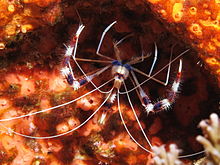| Stenopus hispidus | |
|---|---|

| |
| S. hispidus from Batu Moncho, Indonesia | |
|
Scientific classification
| |
| Domain: | Eukaryota |
| Kingdom: | Animalia |
| Phylum: | Arthropoda |
| Class: | Malacostraca |
| Order: | Decapoda |
| Suborder: | Pleocyemata |
| Family: | Stenopodidae |
| Genus: | Stenopus |
| Species: | S. hispidus
|
| Binomial name | |
| Stenopus hispidus | |
Stenopus hispidus is a shrimp-like decapod crustacean belonging to the infraorder Stenopodidea. Common names include coral banded shrimp and banded cleaner shrimp. [2]
Distribution
Stenopus hispidus has a pan-tropical distribution, [3] extending into some temperate areas. It is found in the western Atlantic Ocean from Canada to Brazil, [4] including the Gulf of Mexico. [3] In Australia, it is found as far south as Sydney and it also occurs around New Zealand. [2]
Description
Stenopus hispidus reaches a total length of 60 millimetres (2.4 in), [2] and has striking colouration. The ground colour is transparent, [5] but the carapace, abdomen and the large third pereiopod are all banded red and white. [2] The antennae and other pereiopods are white. [2] The abdomen, carapace and third pereiopods are covered in spines. [5]
Stenopus hispidus has the ability to detect individuals of its species. This trait is uncommon in invertebrates and is most likely explained through chemical signals. [6]
Ecology
Stenopus hispidus lives below the intertidal zone, at depth of up to 210 metres (690 ft), [2] on coral reefs. [5] It is a cleaner shrimp, and advertises to passing fish by slowly waving its long, white antennae. [5] [7] S. hispidus uses its three pairs of claws to remove parasites, fungi and damaged tissue from the fish. [7] Stenopus hispidus is monogamous. [8] S. hispidus females are typically larger than the males. [9] They occupy a territory that is 1–2 meters in diameter. [10]
Images
-
Top view of S. hispidus ( Chuuk, Micronesia)
-
Front view of S. hispidus
-
Another S. hispidus
References
- ^ Charles Fransen (2010). "Stenopus hispidus (Olivier, 1811)". World Register of Marine Species. Retrieved June 11, 2011.
- ^ a b c d e f Gary C. B. Poore & Shane T. Ahyong (2004). "Stenopodidea – coral shrimps and venus shrimps". Marine Decapod Crustacea of Southern Australia: a Guide to Identification. CSIRO Publishing. pp. 145–149. ISBN 978-0-643-06906-0.
- ^ a b Darryl L. Felder; Fernando Álvarez; Joseph W. Goy & Rafael Lemaitre (2009). "Decapoda Crustacea of the Gulf of Mexico with Comments on the Amphionidacea". In Darryl L. Felder & David K. Camp (eds.). Gulf of Mexico Origin, Waters, and Biota: Biodiversity. Vol. 1. Texas A&M University Press. pp. 1019–1104. ISBN 978-1-60344-094-3.
- ^ "Stenopus hispidus (Olivier, 1811) banded coral shrimp". SeaLifeBase. March 23, 2010. Retrieved June 12, 2011.
- ^ a b c d Gilbert L. Voss (2002). "The crustaceans". Seashore Life of Florida and the Caribbean. Courier Dover Publications. pp. 78–123. ISBN 978-0-486-42068-4.
- ^ Johnson Jr, Victor R. (May 1977). "Individual recognition in the banded shrimp Stenopus hispidus (Olivier)". Animal Behaviour. 25, Part 2: 418–428. doi: 10.1016/0003-3472(77)90017-3. S2CID 53161100.
- ^ a b Brian Morton & John Edward Morton (1983). "The coral sub-littoral". The Sea Shore Ecology of Hong Kong. Hong Kong University Press. pp. 253–300. ISBN 978-962-209-027-9.
- ^ Conrad Limbaugh; Harry Pederson & Fenner A. Chace Jr. (1961). "Shrimps that clean fishes". Bulletin of Marine Science. 11 (2): 237–257.
- ^ "Stenopus hispidus (Red-banded coral shrimp)" (PDF). The Online Guide to the Animals of Trinidad and Tobago: 5. Retrieved October 23, 2019.
- ^ "Stenopus hispidus (Red-banded coral shrimp)" (PDF). The Online Guide to the Animals of Trinidad and Tobago: 5. Retrieved October 23, 2019.
External links
-
 Media related to
Stenopus hispidus at Wikimedia Commons
Media related to
Stenopus hispidus at Wikimedia Commons -
 Data related to
Stenopus hispidus at Wikispecies
Data related to
Stenopus hispidus at Wikispecies - "Coral Banded Shrimp — Stenopus hispidus". ReefCorner.com.
- Photos of Stenopus hispidus on Sealife Collection


